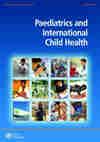A rare cause of stroke in young children: minor head trauma associated with mineralising lenticulostriate angiopathy in three patients
IF 1.4
4区 医学
Q3 PEDIATRICS
引用次数: 1
Abstract
ABSTRACT Acute basal ganglia infarct following minor head trauma in association with mineralisation of lenticulostriate arteries is an increasingly recognised entity in childhood stroke. Three cases with a classical history and phenotypical features of mineralising angiopathy are described. Case 1 was a 2-year-old girl who presented with acute onset hemiparesis with a same-side upper motor neuron (UMN)-type facial palsy following minor head trauma. Case 2 was a 14-month-old boy who presented with a left side hemiparesis and a left UMN-type facial nerve palsy following a minor fall. Case 3 was an 8-month-old boy who, following a fall from his cot, had a sudden-onset hemiparesis on the right side and deviation of the angle of the mouth to the left. In brain computed tomography, all three cases demonstrated characteristic basal ganglia calcification of the mineralising angiopathy. Magnetic resonance imaging of the brain demonstrated features supportive of acute infarcts in the lentiform nucleus, caudate nucleus and putamen. Two of the patients had iron deficiency anaemia with haemoglobin of 7.0 g/dL and 7.8 g/dL, respectively. On follow-up, Case 1 had mild residual weakness and the other two made a complete recovery. None of the patients had a recurrence of stroke. Basal ganglia stroke with mineralising angiopathy should be considered in toddlers presenting with sudden-onset focal neurological deficits preceded by minor head trauma. Abbreviations: ADC: apparent diffusion coefficient; CT: computed tomography; DWI: diffusion-weighted imaging; Hb: haemoglobin; IDA: iron deficiency anaemia; MRI: magnetic resonance imaging; SLV: sonographic lenticulostriate vasculopathy; SWI: susceptibility weighted imaging; UMN: upper motor neuron.幼儿脑卒中的一种罕见原因:三名患者的轻微头部创伤伴矿化性豆纹血管病
摘要轻微头部创伤后并发豆纹动脉矿化的急性基底节梗死在儿童中风中越来越被认可。描述了三例矿化血管病的经典病史和表型特征。病例1是一名2岁女孩,她在轻微头部创伤后出现急性发作性偏瘫,伴有同侧上运动神经元(UMN)型面瘫。病例2是一名14个月大的男孩,在轻微跌倒后出现左侧偏瘫和左侧UMN型面神经麻痹。病例3是一名8个月大的男孩,他从婴儿床上摔下来后,突然出现右侧偏瘫和嘴角向左偏离。在大脑计算机断层扫描中,所有三个病例都表现出矿化血管病的基底节钙化特征。大脑的磁共振成像显示了支持豆状核、尾状核和壳核急性梗死的特征。其中两名患者患有缺铁性贫血,血红蛋白分别为7.0 g/dL和7.8 g/dL。在随访中,病例1有轻微的残余虚弱,另外两例完全康复。没有一个病人中风复发。基底节卒中伴矿化血管病变的幼儿应考虑在轻微头部创伤之前出现突发性局灶性神经功能缺损。缩写:ADC:表观扩散系数;CT:计算机断层扫描;DWI:扩散加权成像;Hb:血红蛋白;IDA:缺铁性贫血;MRI:磁共振成像;SLV:超声显示的豆纹状血管病;SWI:磁化率加权成像;UMN:上运动神经元。
本文章由计算机程序翻译,如有差异,请以英文原文为准。
求助全文
约1分钟内获得全文
求助全文
来源期刊

Paediatrics and International Child Health
PEDIATRICS-
CiteScore
3.30
自引率
0.00%
发文量
19
审稿时长
6-12 weeks
期刊介绍:
Paediatrics and International Child Health is an international forum for all aspects of paediatrics and child health in developing and low-income countries. The international, peer-reviewed papers cover a wide range of diseases in childhood and examine the social and cultural settings in which they occur. Although the main aim is to enable authors in developing and low-income countries to publish internationally, it also accepts relevant papers from industrialised countries. The journal is a key publication for all with an interest in paediatric health in low-resource settings.
 求助内容:
求助内容: 应助结果提醒方式:
应助结果提醒方式:


